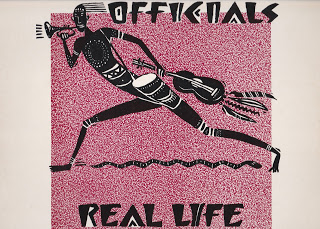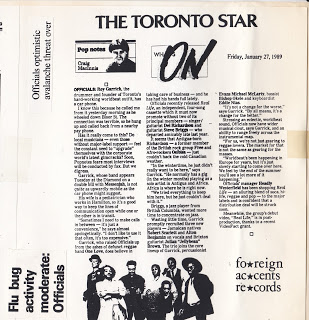 |
| Officials’ 4 song EP with artwork by Barbara Klunder |
This Thursday we’re going to throw it all the way back to 1989, when I was managing Officials, a Worldbeat band in Toronto that had a lot of promise.
It was my 3rd — and my very last — time managing a band, a thankless task if there ever was one. However, I was a fan of every band I managed. It was never about making money, although it was hoped that that would be the eventual outcome.
The first band I ever managed was Ishan People, Toronto’s first Roots Reggae band. I tell that story in greater detail in You Made Me So Very Happy ► My Days With David Clayton-Thomas. However, Ishan People (later Ishan Band) recorded 2 LPs before Canadian Immigration discovered that not everyone in the band had all their documents. The band broke up as some members were deported. Too bad. They were great.
The second band I managed was Drastic Measures. They should have done much better. However, DM was performing Art/Pop Rock when all anyone wanted to hear was Punk. Clever music was simply not breaking through the noise back then.
An unironic cover of the classic Bing Crosby
tune with Nash the Slash on overdubbed violins.
The band fired me after their record producer convinced them they no longer needed a manager because they had a album release. No. Really. I always suspected that he had hoped to manage the band himself, but that never happened. Managerless, Drastic Measures never did break through the noise.
Then in ’89 it was Officials. I originally met leader/drummer Roy Garrick when we both worked as waiters in the same restaurant. Somehow he learned that I had managed bands previously and asked me to listen to Officials to see if I wanted to manage them.
The band set up in a small, sweltering basement near Bathurst and Vaughan. The room was so small it barely contained the band and their equipment. There was nowhere to move. Under these static conditions Officials performed an entire, blistering set for me as the only audience member.
I was blown away. They were easily better than any of the bands I was seeing in Toronto clubs at the time. Officials blended various musical genres. The band members were from many different parts of the globe, making them a true World Beat band. I couldn’t wait to offer my services as manager.
For bonus points, on guitar and vocals was Del Richardson from Osibisa, whose LPs I had promoted years earlier when I worked for Island Records Canada.
 |
| We were grateful to get all these column inches in The Star |
One of the jobs of Manager is stroking the media, trying to get them out to gigs or to review the EP. Or, in this case, both.
Yesterday, while going through my analog file cabinet, I came across a letter I sent to The Toronto Star’s Craig MacInnes, promoting the hell out of the band. [SYNCHRONICITY ALERT: Recently MacInnes and I became facefriends through a mutual face-to-face-friend.]
This came at a transitional period for the band because there had been a recent change in personnel. Consequently, the band bio that I had spent several weeks writing was no longer operative. MacInnes was asking me for biographical info on the new band members in anticipation of an upcoming interview with Garrick.
My reply began:
Firstly, I’d like to thank you for your continued interest and support of OFFICIALS. Secondly, I’d like to apologize for the rushed nature of this information. We were in the process of preparing a new biography. This request just made me do it all the sooner.
 |
| Every review was a feather in my cap |
After describing the new members, I ended the letter with as many strokes as I thought I could give MacInnes — without him thinking I was trying to kiss his ass for a good review — ending with one last plug for my clients:
Well, Craig, that’s about it.
Nobody knows how hard it is for new independent bands starting out like you do. You must hear hundreds of stories like this. It’s good to know you are out there supporting the up and coming bands.
I’ve been working with OFFICIALS for a year now. I managed ISHAN PEOPLE (Canada’s first Reggae band) as well as DRASTIC MEASURES (an early Queen Street W. Art/Rock band). Neither had the staying power and the chance to make it that OFFICIALS do. Unlike other bands working in town now, OFFICIALS are truly a WorldBeat band honestly synthesizing many different rhythms into what we call OFFICIALS’ Style. Conventions are unimportant; what’s important is what works and what sounds good and positive lyrics and a dancable [sic] beat. Nothing else enters into it. But, don’t take my word for it. Come down to the Diamond Club and hear us. I know you’ll like the band.
Thank you for all your time and trouble on our behalf.
The letter led to a phone interview published 3 days later (see above), so I guess it did the trick.
What I find highly amusing in retrospect is that MacInnes begins with his amazement that Roy Garrick has a car phone at a time when The Brick was the new cell phone technology. Now, 27 years later, most of us carry a phone in our pocket.
All good things must come to an end. My tenure with Officials ended spectacularly: I quit after the band held back money owed to me following an extremely well-paying 2-week gig in the Caribbean.
The agreement we had was not the standard manager/band contract. As opposed to a percentage, we split the proceeds equally (after expenses), which gave me a smaller percentage than I would have as a manager. However, it gave us all equal incentive to take it all to the next level.
When I quit I naturally had all of the band’s files, including distribution contracts, band bios, glossies, and all the promo material, in my analog file cabinet. I became THAT asshole: I refused to turn it over to the band unless they paid the money owed to me from previous gigs. We settled on $2500 and the band signed a promissory note for the money. It has never been paid. It was also one of the documents I discovered yesterday.
A few years back I created a video from one of Officials’ songs. I hope you like it, but I guess I don’t really care all that much.







